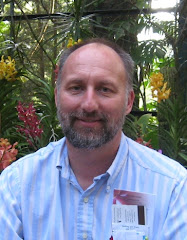Tibet has always been on my bucket list for traveling. I don't know why, and I'm not sure what I expected to see there. But it was, so I convinced Cindy to go. I particularly chose a time when there would be a festival we could visit, and would also fit in with my work schedule. As it turned out, my work schedule changed a bit, and it wasn't a great time to go, but the trip was booked, so we went anyways.
We did have some concerns about the altitude. Lhasa, the main city where we went, is at 3,490 meters (11,450 ft). Many of my colleagues were shocked that we planned to fly there instead of acclimating by taking the new train which goes there. The train would have been a fun and interesting experience, but I didn't really have the time to spend 48 hours in the train. First off we arranged the trip through a tour agency. Foreigners cannot go there without engaging a tour operator. We went on a tour of 2--customized to our desires. Then after we had that arranged, we had to get permission to travel to Tibet from the government, our permits were arranged through the tour operator, so it was pretty painless for us. The permits were very necessary though. They were checked before we got our boarding passes at the airport, again at the airport when we got off, and again at the first of dozens of police checkpoints we went through. This one on the main highway from the airport to Lhasa. I have to say, in all my travels, I've never seen so many police checkpoints, and security points, and ... It was a bit intimidating.
The first day we arrived in the afternoon, and drove to Lhasa. We checked in the hotel, and rested--getting acclimated. We could see the Potala Palace from our window, but the most striking thing was all of the construction going on in Lhasa. There were cranes everywhere.
Our guide Pintok arranged for us to visit the palace early in the morning--meaning we had a 9:45 entrance time. Non Tibetan visitors are required to get an appointment to visit the palace to manage the crowd control. So we were there at almost 3500 meters, and we had to climb hundreds of steps to get into the palace, fortunately since it was early, the sun wasn't beating down on us too hard--the skys were clear though, a nice break from the overcast cloudy/polluted air of Hangzhou.
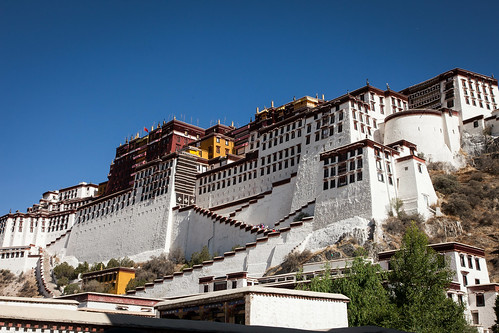 There were dozens of people climbing the stairs up at any section, most of them Chinese visitors, followed in numbers by Tibetans who often make a once in a lifetime pilgrimage to the former residence of the Dali Lama. Of course we had to go through a security check, xray scan, metal detector, to get into the grounds.
There were dozens of people climbing the stairs up at any section, most of them Chinese visitors, followed in numbers by Tibetans who often make a once in a lifetime pilgrimage to the former residence of the Dali Lama. Of course we had to go through a security check, xray scan, metal detector, to get into the grounds. 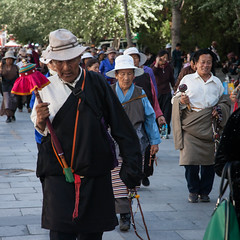
Down below the palace, many people were walking around the palace as a form of devotion. It took us probably an hour to an hour and a half to walk up all the stairs, and then we walked around inside.
Inside there are rooms where the Dali Lama lived, there are tombs of some of the past Dali Lamas, there are said to be 1000 rooms in the palace. Construction started on the modern palace in 1645, and it has been updated/added to several times. It also suffered some damage in the occupation and cultural uprising, but was protected by Zhou Enlai who recognized it as an important cultural place.
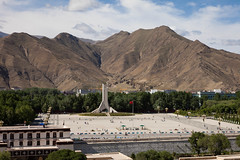 When you are climbing up, you can see the large people's square which was built by the Chinese in front of the palace.
When you are climbing up, you can see the large people's square which was built by the Chinese in front of the palace. 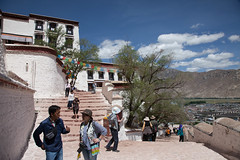 And after seeing the palace, and the many beautiful artworks there, you descend another set of steps on the back side of the palace.
And after seeing the palace, and the many beautiful artworks there, you descend another set of steps on the back side of the palace.
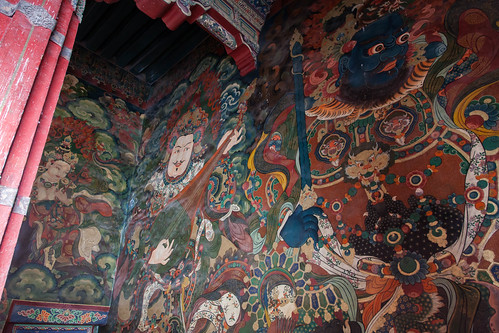
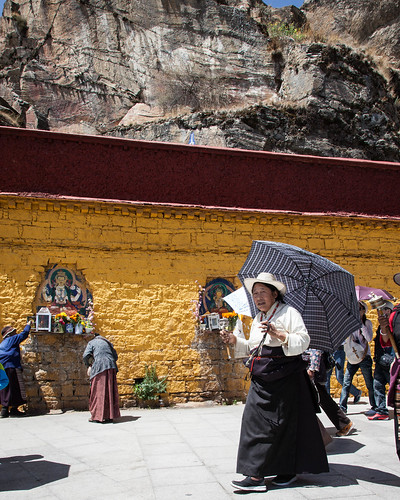
After the palace, we had lunch, and then proceeded to visit the Jokung Temple.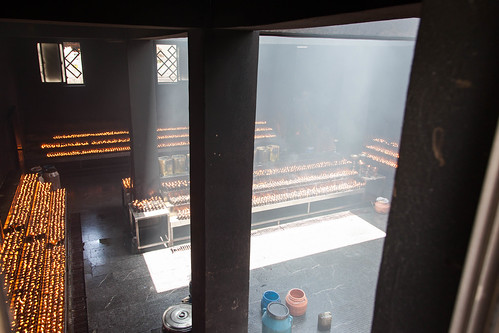 Outside the temple, there was a "sunken" building where there were oil lamps lit. These were all yak butter lamps. Everywhere we went there were yak butter lamps/candles. People would bring in either thermos' of melted yak butter (even in the palace) or they would have bags of yak butter. In some places they also brought barley or barley flour.
Outside the temple, there was a "sunken" building where there were oil lamps lit. These were all yak butter lamps. Everywhere we went there were yak butter lamps/candles. People would bring in either thermos' of melted yak butter (even in the palace) or they would have bags of yak butter. In some places they also brought barley or barley flour. Every monastery or temple we went to had these beautiful paintings. Sometimes they were darkened with soot, or damaged by water, but mostly they were in good shape and absolutely stunning in detail and execution.
Every monastery or temple we went to had these beautiful paintings. Sometimes they were darkened with soot, or damaged by water, but mostly they were in good shape and absolutely stunning in detail and execution. 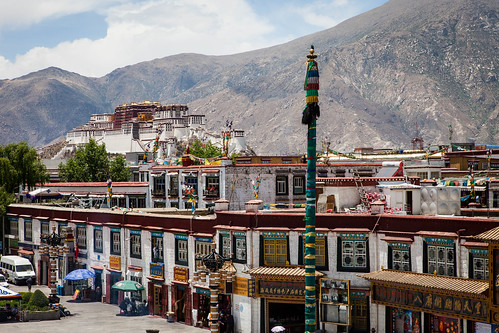 From the roof, one had a good view of the Potala Palace in the background, and the main shopping street which went around the temple.
From the roof, one had a good view of the Potala Palace in the background, and the main shopping street which went around the temple.
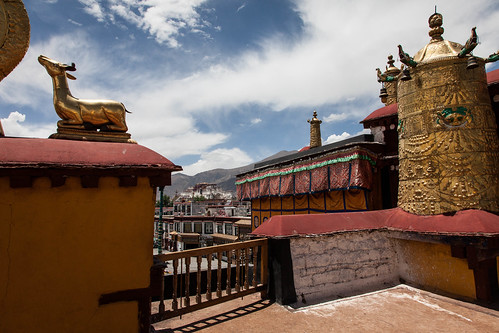
The second day was probably the highlight of the trip for both of us. Cindy had seen Cham Dancing before, but I hadn't. We went to a festival about an hour outside of the city at Tsuphu. We had to park about a kilometer below the temple site in the village, and walk up. Here we were approaching the actual temple grounds, there were probably thousands of people who came for this. It had a real local country fair kind of atmosphere. There were incense vendors, food (cooked and uncooked) vendors, dozens of buses which had brought people parked in the parking lot, and people milling about everywhere.
We had to park about a kilometer below the temple site in the village, and walk up. Here we were approaching the actual temple grounds, there were probably thousands of people who came for this. It had a real local country fair kind of atmosphere. There were incense vendors, food (cooked and uncooked) vendors, dozens of buses which had brought people parked in the parking lot, and people milling about everywhere.
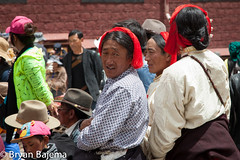
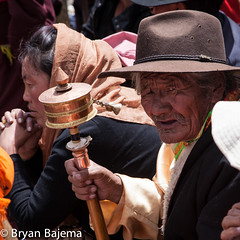
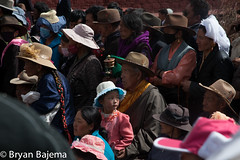 And Cindy, as always, made a friend:
And Cindy, as always, made a friend:
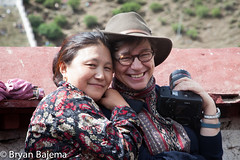
At first when we arrived, we had a tough time getting close enough to the festivities to really get good photos. Here you can see the opening procession.
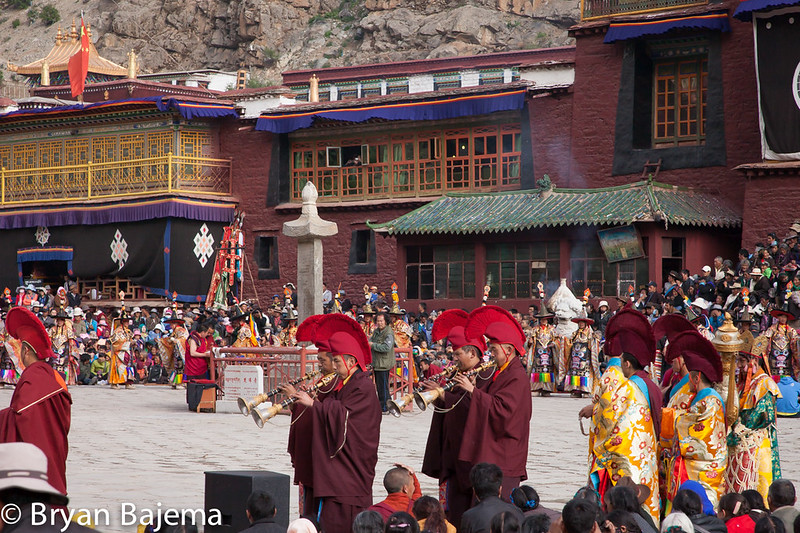
Also some of the dancing:
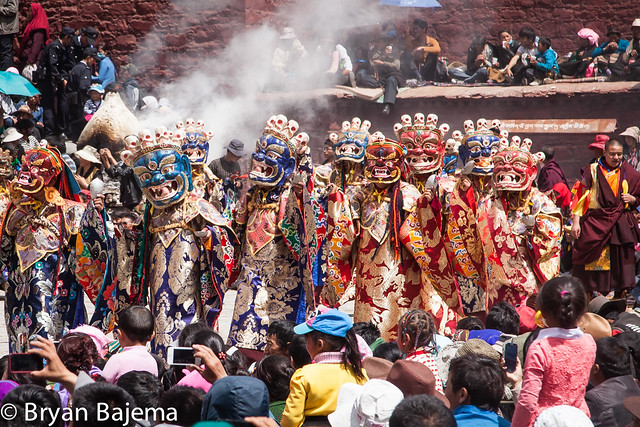
Eventually I braved the "intermission dancers/clowns" who did crowd control, and entertained people during the time between the main dances. I got close in on the main square and took some photos up close.
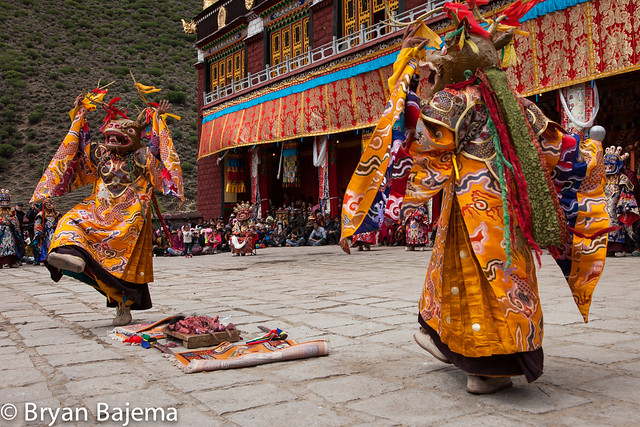
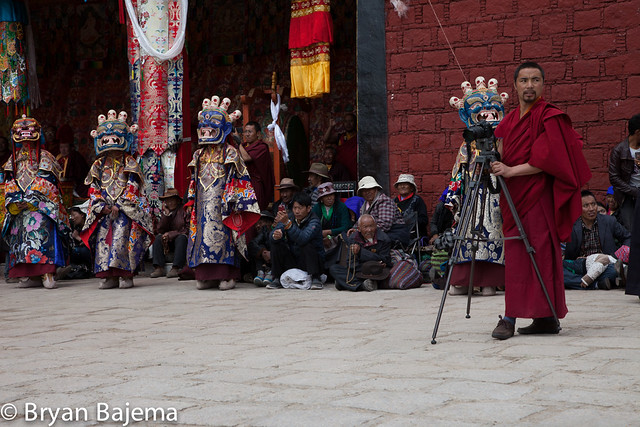
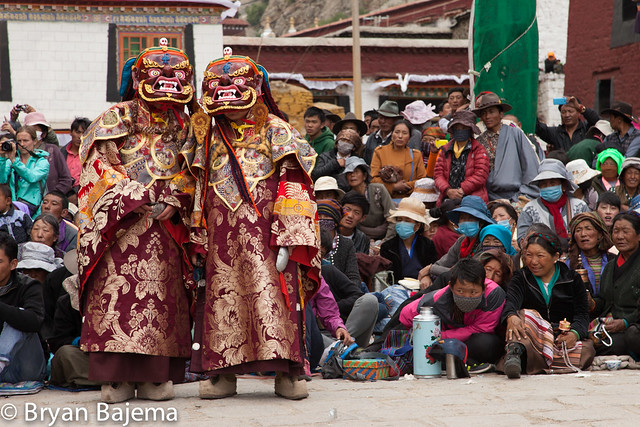
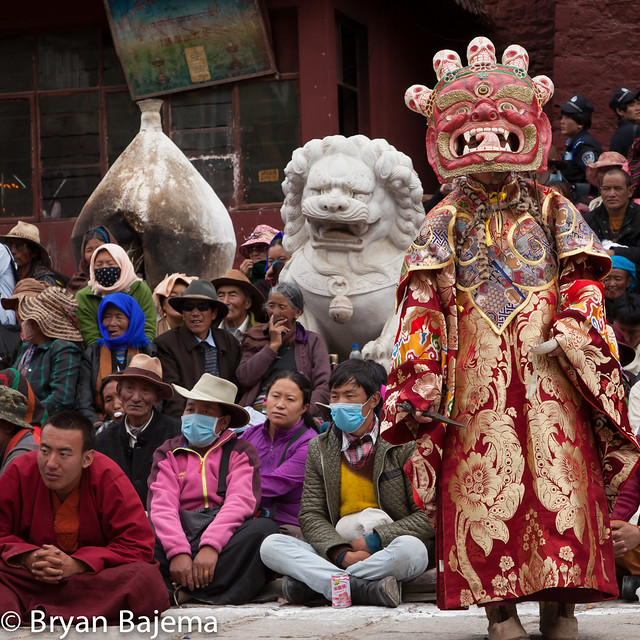
Please visit my Flickr page to see more photos of the festivities, and a couple of videos I took there.
We spent pretty much the whole day there at the festival, having a bite to eat at about 3pm in a local tent on the way back down to the car. I had some spicy noodles, Cindy had some rice dish, I don't remember exactly what. They were especially happy to serve us yak butter tea, the local drink.
The third day we stayed around Lhasa again. By now we were fairly well acclimated to the altitude in Lhasa, so that didn't bother us too much. In the morning we went to the Dali Lama's summer palace/gardens. I don't have many pictures because although the gardens were beautiful, I suffered massively from allergies and was miserable most of the morning. I started to feel better after we had some lunch and I got away from the blooming trees in the gardens.
In the after noon we went to the Sera monastery. The key interest in this monastery is the debating monks. They do it every day. It seems to have become a real tourist attraction, and one wonders how authentic it is any more, but it represents how the monks "debate" or more accurately question one another on scripture. Some of them are very dramatic about it, seeming to have a lot of fun, others are more sedate or serious. Whatever, they definitely put on a show. They pose the question, and then clap their hands, leaving one extended towards the recipient of the question.
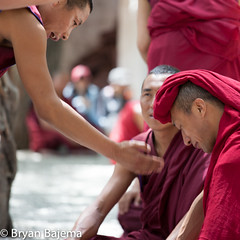
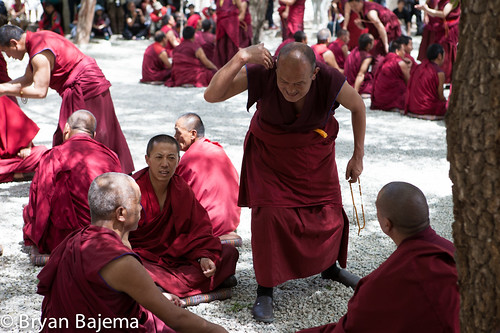
We also toured the inside of the monastery here. Again many more paintings, sculptures, etc. Most of the monasteries we visited charged to take pictures inside. It usually wasn't much, 2 or 3 dollars, but it added up over time, so we didn't always take photos inside.
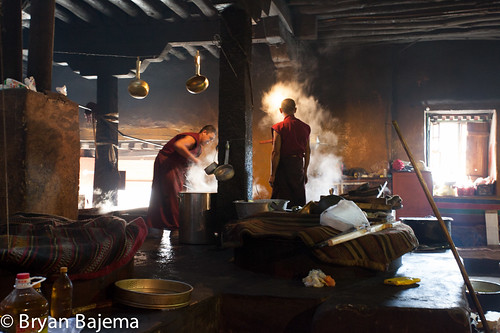 We also got to visit the kitchens, where a couple of monks were preparing something for the rest.
We also got to visit the kitchens, where a couple of monks were preparing something for the rest.
Our last day in and around Lhasa, we went to a monastery recommended by our guide. He wanted to take us for a short (1/2 hour) trek around the mountain the monastery is perched on. So we went to Ganden monastery. First about an hour driving out of the city, and then a fairly steep windy road up the mountainside. 2/3 of the way up, we stopped for a break.
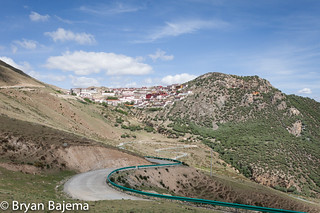
You can make out where the actual monastery is by the red color in the mountain, and off to the right is a small hermit's residence/ chapel. We walked by it on our way back around the mountain.
Cindy made more friends, this time the four footed kind...
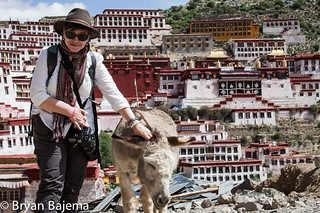
And we has some spectacular views of the monastery itself, and off the mountain down into the valleys.
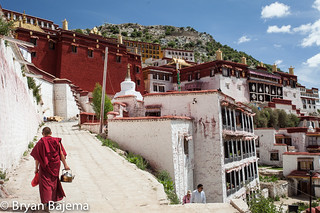
Here you can see a local person carrying flagstones up the stairs to a higher point. Vehicles just cannot make it this far.
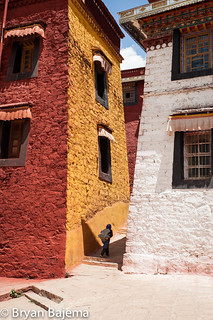
We bought some prayer flags, and hung them behind the monastery.
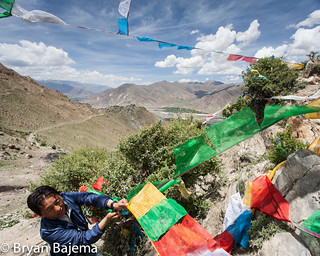
The sky was superb that day. Lots of beautiful clouds blowing by.
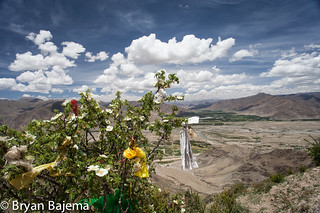 And people tied flags, or left yak wool in the bushes for good fortune/blessings.
And people tied flags, or left yak wool in the bushes for good fortune/blessings.
Here you see more prayer flags left above the spot where sky burials are performed. The burials are off to the left down the mountain a bit. It is a very special ceremony carried out by specific monks.
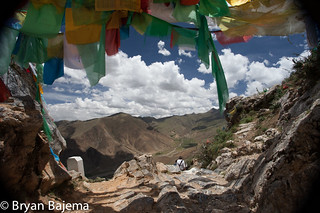
Well that is it for the first half of our trip. As always, there are more photos from the various sites on my flickr.
More about the 2nd half later.
We did have some concerns about the altitude. Lhasa, the main city where we went, is at 3,490 meters (11,450 ft). Many of my colleagues were shocked that we planned to fly there instead of acclimating by taking the new train which goes there. The train would have been a fun and interesting experience, but I didn't really have the time to spend 48 hours in the train. First off we arranged the trip through a tour agency. Foreigners cannot go there without engaging a tour operator. We went on a tour of 2--customized to our desires. Then after we had that arranged, we had to get permission to travel to Tibet from the government, our permits were arranged through the tour operator, so it was pretty painless for us. The permits were very necessary though. They were checked before we got our boarding passes at the airport, again at the airport when we got off, and again at the first of dozens of police checkpoints we went through. This one on the main highway from the airport to Lhasa. I have to say, in all my travels, I've never seen so many police checkpoints, and security points, and ... It was a bit intimidating.
The first day we arrived in the afternoon, and drove to Lhasa. We checked in the hotel, and rested--getting acclimated. We could see the Potala Palace from our window, but the most striking thing was all of the construction going on in Lhasa. There were cranes everywhere.
Our guide Pintok arranged for us to visit the palace early in the morning--meaning we had a 9:45 entrance time. Non Tibetan visitors are required to get an appointment to visit the palace to manage the crowd control. So we were there at almost 3500 meters, and we had to climb hundreds of steps to get into the palace, fortunately since it was early, the sun wasn't beating down on us too hard--the skys were clear though, a nice break from the overcast cloudy/polluted air of Hangzhou.
 There were dozens of people climbing the stairs up at any section, most of them Chinese visitors, followed in numbers by Tibetans who often make a once in a lifetime pilgrimage to the former residence of the Dali Lama. Of course we had to go through a security check, xray scan, metal detector, to get into the grounds.
There were dozens of people climbing the stairs up at any section, most of them Chinese visitors, followed in numbers by Tibetans who often make a once in a lifetime pilgrimage to the former residence of the Dali Lama. Of course we had to go through a security check, xray scan, metal detector, to get into the grounds. 
Down below the palace, many people were walking around the palace as a form of devotion. It took us probably an hour to an hour and a half to walk up all the stairs, and then we walked around inside.
Inside there are rooms where the Dali Lama lived, there are tombs of some of the past Dali Lamas, there are said to be 1000 rooms in the palace. Construction started on the modern palace in 1645, and it has been updated/added to several times. It also suffered some damage in the occupation and cultural uprising, but was protected by Zhou Enlai who recognized it as an important cultural place.
 When you are climbing up, you can see the large people's square which was built by the Chinese in front of the palace.
When you are climbing up, you can see the large people's square which was built by the Chinese in front of the palace.  And after seeing the palace, and the many beautiful artworks there, you descend another set of steps on the back side of the palace.
And after seeing the palace, and the many beautiful artworks there, you descend another set of steps on the back side of the palace.

After the palace, we had lunch, and then proceeded to visit the Jokung Temple.
 Outside the temple, there was a "sunken" building where there were oil lamps lit. These were all yak butter lamps. Everywhere we went there were yak butter lamps/candles. People would bring in either thermos' of melted yak butter (even in the palace) or they would have bags of yak butter. In some places they also brought barley or barley flour.
Outside the temple, there was a "sunken" building where there were oil lamps lit. These were all yak butter lamps. Everywhere we went there were yak butter lamps/candles. People would bring in either thermos' of melted yak butter (even in the palace) or they would have bags of yak butter. In some places they also brought barley or barley flour. Every monastery or temple we went to had these beautiful paintings. Sometimes they were darkened with soot, or damaged by water, but mostly they were in good shape and absolutely stunning in detail and execution.
Every monastery or temple we went to had these beautiful paintings. Sometimes they were darkened with soot, or damaged by water, but mostly they were in good shape and absolutely stunning in detail and execution.  From the roof, one had a good view of the Potala Palace in the background, and the main shopping street which went around the temple.
From the roof, one had a good view of the Potala Palace in the background, and the main shopping street which went around the temple.
The second day was probably the highlight of the trip for both of us. Cindy had seen Cham Dancing before, but I hadn't. We went to a festival about an hour outside of the city at Tsuphu.
 We had to park about a kilometer below the temple site in the village, and walk up. Here we were approaching the actual temple grounds, there were probably thousands of people who came for this. It had a real local country fair kind of atmosphere. There were incense vendors, food (cooked and uncooked) vendors, dozens of buses which had brought people parked in the parking lot, and people milling about everywhere.
We had to park about a kilometer below the temple site in the village, and walk up. Here we were approaching the actual temple grounds, there were probably thousands of people who came for this. It had a real local country fair kind of atmosphere. There were incense vendors, food (cooked and uncooked) vendors, dozens of buses which had brought people parked in the parking lot, and people milling about everywhere.

 And Cindy, as always, made a friend:
And Cindy, as always, made a friend:
At first when we arrived, we had a tough time getting close enough to the festivities to really get good photos. Here you can see the opening procession.

Also some of the dancing:

Eventually I braved the "intermission dancers/clowns" who did crowd control, and entertained people during the time between the main dances. I got close in on the main square and took some photos up close.




Please visit my Flickr page to see more photos of the festivities, and a couple of videos I took there.
We spent pretty much the whole day there at the festival, having a bite to eat at about 3pm in a local tent on the way back down to the car. I had some spicy noodles, Cindy had some rice dish, I don't remember exactly what. They were especially happy to serve us yak butter tea, the local drink.
The third day we stayed around Lhasa again. By now we were fairly well acclimated to the altitude in Lhasa, so that didn't bother us too much. In the morning we went to the Dali Lama's summer palace/gardens. I don't have many pictures because although the gardens were beautiful, I suffered massively from allergies and was miserable most of the morning. I started to feel better after we had some lunch and I got away from the blooming trees in the gardens.
In the after noon we went to the Sera monastery. The key interest in this monastery is the debating monks. They do it every day. It seems to have become a real tourist attraction, and one wonders how authentic it is any more, but it represents how the monks "debate" or more accurately question one another on scripture. Some of them are very dramatic about it, seeming to have a lot of fun, others are more sedate or serious. Whatever, they definitely put on a show. They pose the question, and then clap their hands, leaving one extended towards the recipient of the question.


We also toured the inside of the monastery here. Again many more paintings, sculptures, etc. Most of the monasteries we visited charged to take pictures inside. It usually wasn't much, 2 or 3 dollars, but it added up over time, so we didn't always take photos inside.
 We also got to visit the kitchens, where a couple of monks were preparing something for the rest.
We also got to visit the kitchens, where a couple of monks were preparing something for the rest.Our last day in and around Lhasa, we went to a monastery recommended by our guide. He wanted to take us for a short (1/2 hour) trek around the mountain the monastery is perched on. So we went to Ganden monastery. First about an hour driving out of the city, and then a fairly steep windy road up the mountainside. 2/3 of the way up, we stopped for a break.

You can make out where the actual monastery is by the red color in the mountain, and off to the right is a small hermit's residence/ chapel. We walked by it on our way back around the mountain.
Cindy made more friends, this time the four footed kind...

And we has some spectacular views of the monastery itself, and off the mountain down into the valleys.

Here you can see a local person carrying flagstones up the stairs to a higher point. Vehicles just cannot make it this far.

We bought some prayer flags, and hung them behind the monastery.

The sky was superb that day. Lots of beautiful clouds blowing by.
 And people tied flags, or left yak wool in the bushes for good fortune/blessings.
And people tied flags, or left yak wool in the bushes for good fortune/blessings.Here you see more prayer flags left above the spot where sky burials are performed. The burials are off to the left down the mountain a bit. It is a very special ceremony carried out by specific monks.

Well that is it for the first half of our trip. As always, there are more photos from the various sites on my flickr.
More about the 2nd half later.
